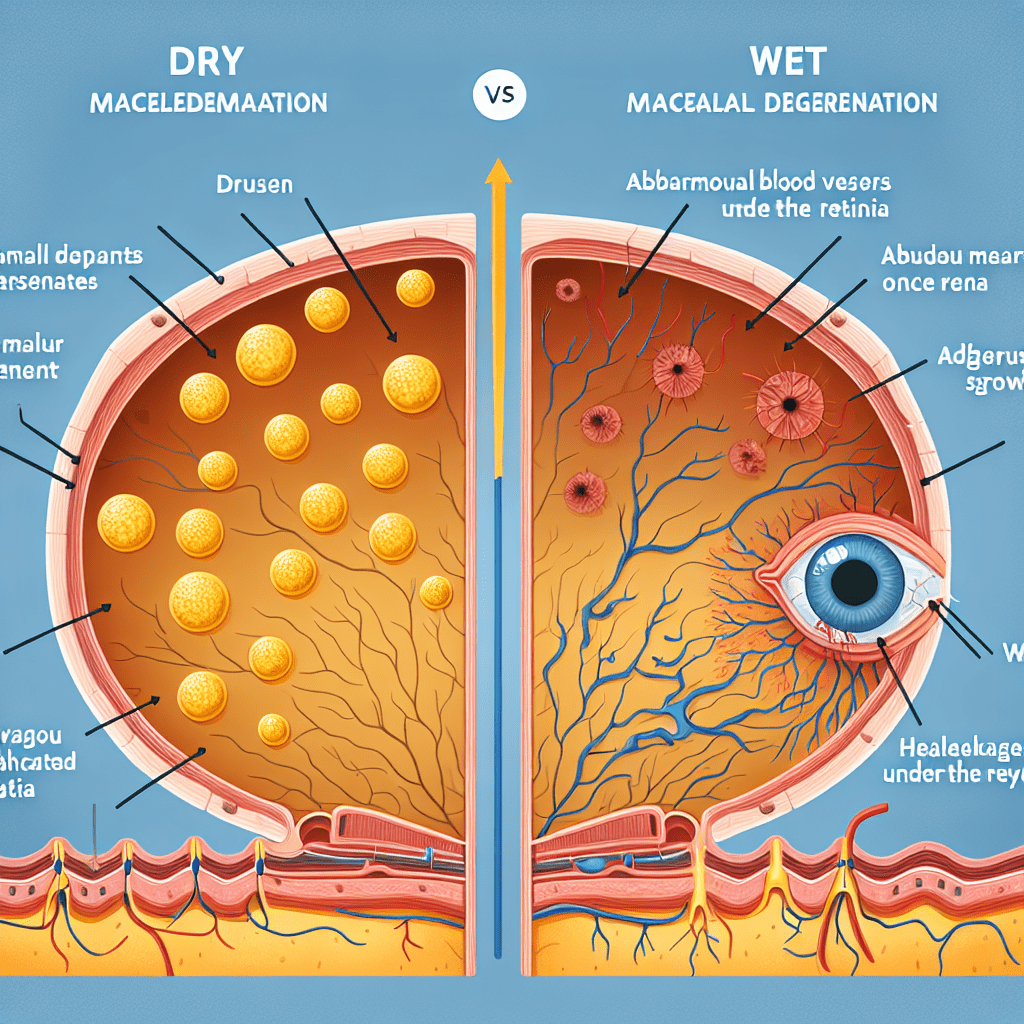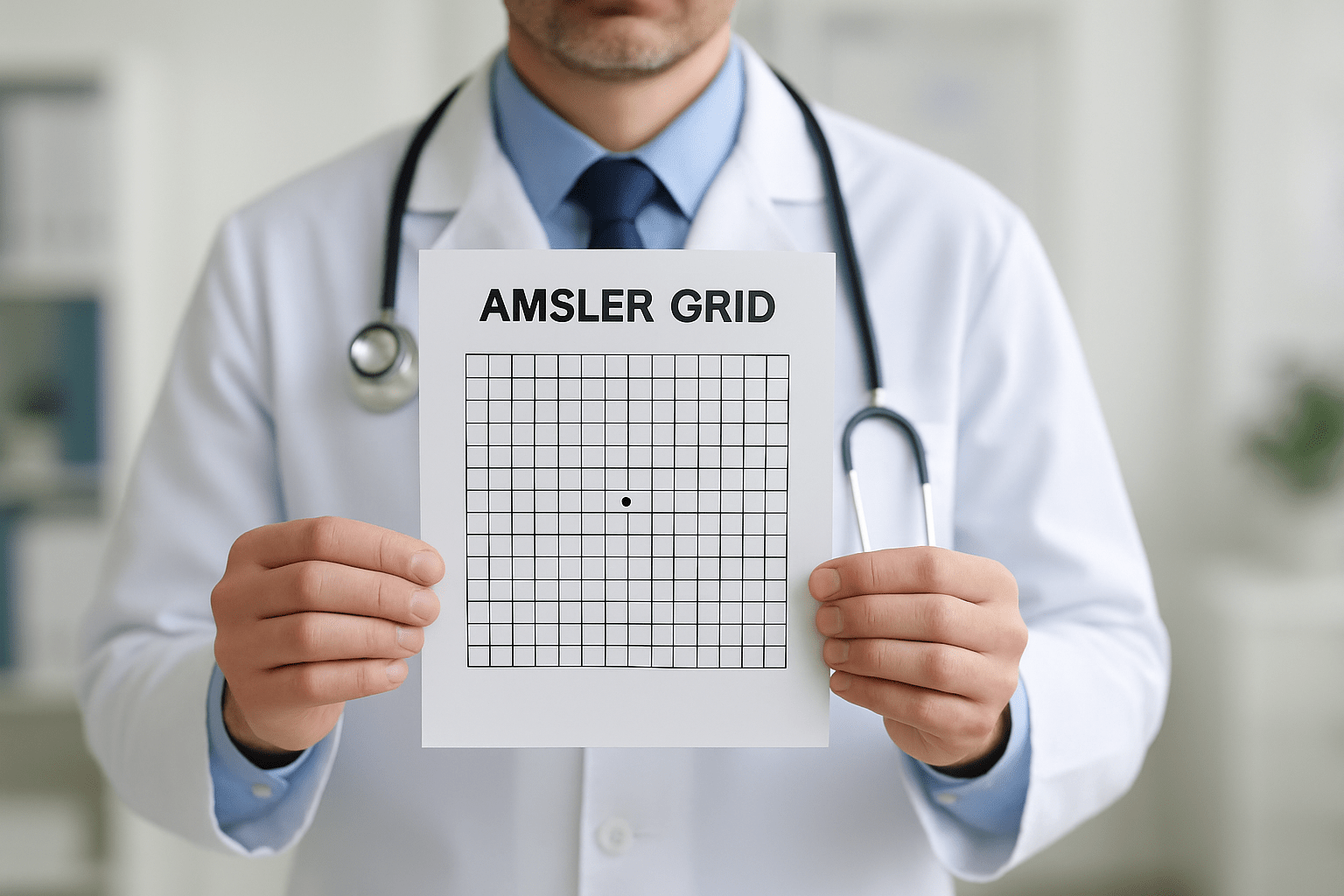🧿 Difference Between Dry and Wet Macular Degeneration: Simple Guide for Everyone
Macular Degeneration — also known as Age-Related Macular Degeneration (AMD) — is an eye disease that affects the central vision. This is the vision you use to read, drive, recognize faces, or see details.
If you or someone you love is newly diagnosed, this article will help you understand:
✔ Difference between Dry and Wet AMD
✔ Symptoms you should watch for
✔ Treatment options
✔ Home exercises for relief
✔ Lifestyle precautions
✔ When to get help
✔ Trusted sources for further reading
This guide is written in simple, everyday English so anyone can understand.
Save this article now for future reference — AMD is a long-term condition.
⭐ What Is the Macula? (Very Simple Explanation)
The macula is a small part of the retina that gives you sharp, clear, detailed vision.
When it becomes damaged, everything you see in the center becomes:
-
Blurry
-
Distorted
-
Dark
-
Less colorful
Peripheral (side) vision usually stays normal.
🟡 1. What Is Dry Macular Degeneration?
Dry AMD is the most common form (about 80–90% of cases).
It happens slowly over years.
✔ Causes
Dry AMD occurs because the macula becomes thin and tiny yellow deposits called drusen form under the retina.
✔ Symptoms
-
Slightly blurry central vision
-
Difficulty reading small text
-
Colors look dull
-
Trouble seeing in low light
-
Slow, gradual vision loss
✔ Dry AMD Progress Speed
Slow → usually many years.
Most people do NOT suddenly lose vision.
✔ Treatment
There is no cure, but vision can be protected through:
-
AREDS2 vitamins
-
Healthy eye diet
-
Regular check-ups
-
Managing blood pressure, cholesterol, diabetes
-
Strong light when reading
🔴 2. What Is Wet Macular Degeneration?
Wet AMD is less common but more serious.
It develops when abnormal blood vessels grow under the retina and leak blood or fluid.
✔ Symptoms
Wet AMD causes faster and more severe vision changes:
-
Sudden blurry or wavy vision
-
Dark or blank spot in the center
-
Fast distortion (straight lines appear bent)
-
Colors look washed out
-
Rapid vision loss (days to weeks)
✔ Progress Speed
Very fast → requires urgent treatment.
✔ Treatment
Wet AMD can be controlled with:
-
Anti-VEGF injections (Eylea, Lucentis, Avastin)
-
Laser therapy (rarely used now)
Early treatment can save vision.
⭐ 3. Main Difference Between Dry & Wet AMD (Easy Table)
| Feature | Dry AMD | Wet AMD |
|---|---|---|
| How common? | Very common (80–90%) | Less common (10–15%) |
| Progress speed | Slow (years) | Fast (days–weeks) |
| Changes in retina | Thinning + drusen | Leaking blood vessels |
| Vision loss | Mild → moderate | Moderate → severe |
| Emergency? | No | Yes, urgent treatment needed |
| Treatment | Supplements, lifestyle | Eye injections, lasers |
🏠 4. Home-Based Eye Exercises for Macular Relief
(These do NOT cure AMD but improve comfort, focus, and eye muscle strength.)
1. 20–20–20 Rule (Most Important)
Every 20 minutes:
→ Look 20 feet away
→ For 20 seconds
✔ Reduces eye strain
✔ Helps dry AMD discomfort
2. Pencil Focus Exercise
Good for maintaining focusing ability.
-
Hold a pencil 30 cm from your eyes
-
Focus on the tip
-
Slowly move it toward your nose
-
Then move it back
Repeat: 10 times daily
3. Blinking Exercise (for dryness relief)
Blink quickly for 5 seconds
Then blink slowly for 10 seconds
Repeat 5 times
✔ Helps dryness
✔ Reduces irritation
4. Warm Eye Compress
-
Use a warm clean cloth
-
Place it on eyes for 5 minutes
✔ Improves blood flow
✔ Relaxation
✔ Helps dry eye symptoms
🔒 5. Precautions for People with AMD
✔ Regular Eye Check-Ups (Very Important)
-
Every 6 months for Dry AMD
-
Immediately if any sudden changes occur
✔ Use the Amsler Grid Weekly
This simple test helps detect early Wet AMD.
If straight lines look wavy, broken, or missing — call your eye doctor.
✔ Healthy Diet for Eye Protection
Eat foods rich in:
-
Spinach, kale
-
Carrots
-
Eggs
-
Salmon, tuna
-
Nuts and seeds
-
Berries
✔ Avoid These
-
Smoking (biggest risk factor)
-
Junk food
-
High blood pressure
-
High cholesterol
✔ Protect Eyes from Sun
Wear sunglasses with UV400 protection.
⭐ 6. When Should You Visit a Doctor?
Get help immediately if:
-
You suddenly see wavy lines
-
You notice a dark spot in the center
-
Colors look faded overnight
-
Blurriness increases quickly
-
You lose vision in one eye suddenly
These are signs of Wet AMD, which needs urgent treatment.
⭐ 7. Can AMD Be Prevented?
You can reduce risk by:
-
Not smoking
-
Eating eye-healthy foods
-
Controlling blood pressure
-
Wearing sunglasses
-
Getting regular eye exams
🔍 Further Reading (Trusted Sources)
These links are safe, medical, and reliable:
-
Mayo Clinic – AMD Overview:
https://www.mayoclinic.org/diseases-conditions/macular-degeneration -
National Eye Institute:
https://www.nei.nih.gov/learn-about-eye-health/eye-conditions-and-diseases/macular-degeneration -
American Academy of Ophthalmology:
https://www.aao.org/eye-health/diseases/amd-macular-degeneration
Save this article and revisit it often — AMD is a long-term condition and information helps you stay prepared.
✅FAQ
Q1. What is the main difference between dry and wet macular degeneration?
Dry AMD develops slowly over years, while wet AMD progresses quickly because of leaking blood vessels under the retina.
Q2. Is wet macular degeneration more serious?
Yes. Wet AMD can cause fast and severe vision loss if untreated.
Q3. Can dry macular degeneration turn into wet?
Yes. A small percentage of dry AMD cases later become wet AMD.
Q4. What are early symptoms of AMD?
Blurry central vision, difficulty reading, faded colors, and wavy/distorted lines.
Q5. How is wet AMD treated?
Wet AMD is treated with anti-VEGF eye injections, sometimes lasers.
Q6. What vitamins help AMD?
AREDS2 supplements help slow down dry AMD progression.
Q7. Can exercises improve AMD?
Exercises do not cure AMD but help reduce eye strain and improve comfort.
Q8. What lifestyle changes help AMD?
Stop smoking, eat leafy greens, protect eyes from sunlight, control blood pressure.
Q9. Should you see a doctor for sudden vision changes?
Yes — sudden changes may be signs of wet AMD and require urgent treatment.
Q10. Is AMD reversible?
No, but treatment and lifestyle changes can protect remaining vision.
Also Read- 👇
What Is Walmart’s DEI Program? (Diversity, Equity & Inclusion Explained)
3I/ATLAS: Is the Interstellar Object Alien Technology?
Mystery From the Sky: The Buga Sphere Appears in Colombia
Oumuamua: The Mysterious Interstellar Visitor and the Cosmic Message in Prashyant Jha’s Song
Hz Frequency Generator- Free Online Tone Generator
Also Read- 👉
👉What is 7 Hz good for? A careful, evidence-based guide (with references)
👉Cymatics: From 2D Sand Patterns to 3D Sound Sculptures
👉 Music Therapy Lab – Complete Guide to Healing Through Sound Frequencies
👉 Hz Frequency Generator- Free Online Tone Generator
👉 What Frequencies Are Dangerous to Humans? Understanding Risks from Sound to Radiation
👉How to do a Cymatic Experiment
👉What is the science behind cymatics?
👉 NASA-Approved 30-Min Brain Boost
👉 What Is The Healing Power Of Sound Wave
👉 What does 528 hz do to the brain?
👉 The 7 Healing Frequencies: Unlocking the Power of Sound for Wellness
👉 The Sacred Science of Yantras: How Cymatics Validates Ancient Tantric Geometry
👉 Is 1111 a Lucky Number? A Deep Dive into Its Mystical, Numerological, and Cultural Significance
People Also Read
- 2030 A Doomsday According to Indian Texts or Misinterpretation?
- The Glory of Narasimha Bhagwan: An Exploration of Ancient Indian History
- Medusa and Mansa Devi: The Untold Myths Connecting Greek and Hindu Traditions
- “The Enigmatic Link Between the Bermuda Triangle and Hindu Mythology of Ramayan: Unveiling the Mystery”
- why is mt. Kailash Considered to be a Sacred Site?
- How Eastern Wisdom Can Transform Your Modern Life.
- Lord Shani and Lord Yam : God of Karma for Living and Death
- In which direction Ganesh Idol should face.
- What is the logic for existence of God?
- Who Is Mahadev Shiv ?
- How to increase love for Krishna?
- Hanuman Chalisa English Lyrics| Bhajle Ram Naam | Prashyant Jha
Free AI Tools To test yourself
- Love Percentage Checker Tool – Check For Free!
- Soulmates Initial Finder
- Hz Frequency Generator- Free Online Tone Generator
- Mental Health Check In Tool [ FREE TEST ]
- Best Free Phone Photos Download
- Image Converter (Online & Free)
Seotoolrank.com Free Ai Tools
- RankVortex – Implies pulling traffic and SEO rankings toward you.
- How do I convert a PNG file to BMP?
- ConvertEase PDF
- Website Speed Checker Tool
- SEO Word Counter with Character Count
- Free Stopwatch and Online Timer Countdown
- Age Calculator Tool
- Password Generator Tool
- Qr Code Generator Free
- AI Story Generator Tool
- Blog Title Generator Tool [FREE]




[…] to the macula. This introduction aims to provide an overview of the success of injections for wet macular […]